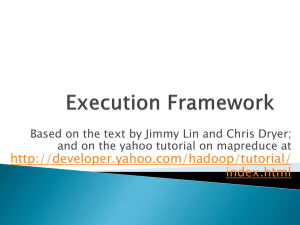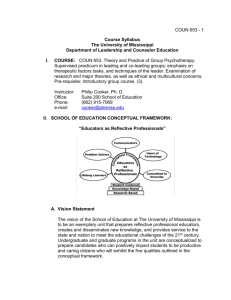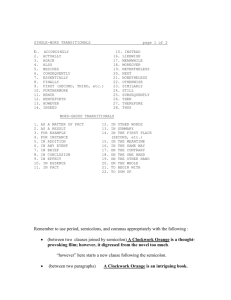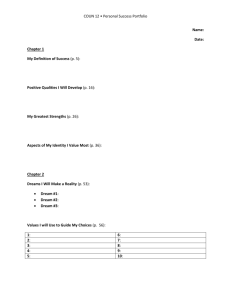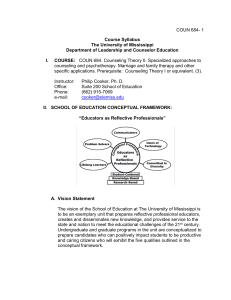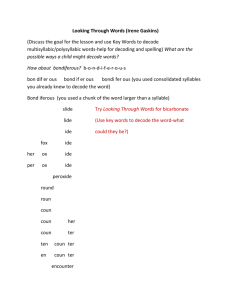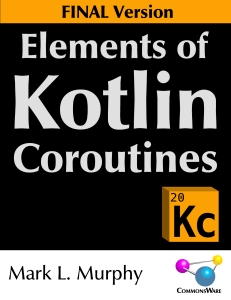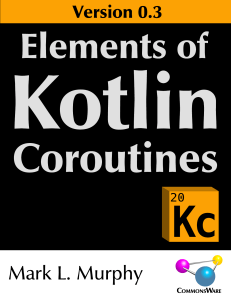Coroutines & Data Stream Processing
advertisement
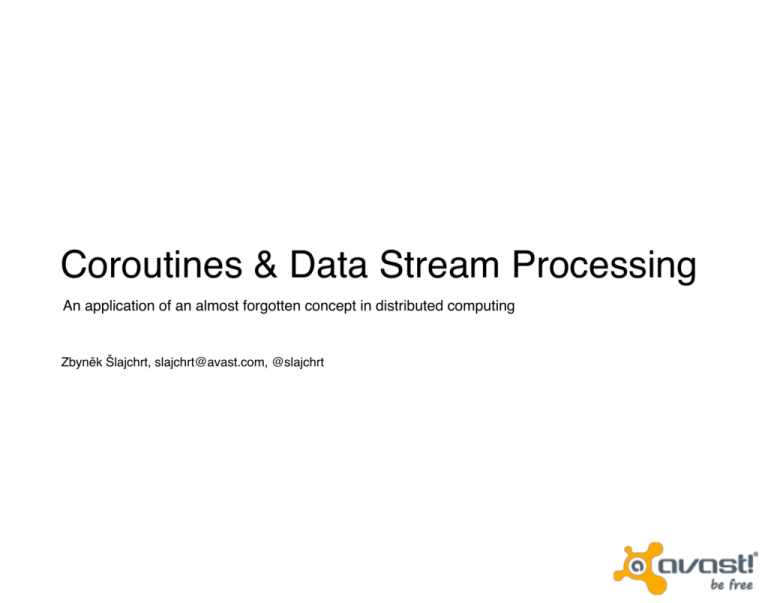
Coroutines & Data Stream Processing An application of an almost forgotten concept in distributed computing Zbyněk Šlajchrt, slajchrt@avast.com, @slajchrt Agenda "Strange" Iterator Example Coroutines MapReduce & Coroutines Clockwork Conclusion Q&A Joining Multiple Iterators To One Joining Iterators - A Traditional Approach Joining Iterators - A Less-Traditional Approach Joining Iterators To One - A Pipe Joining Iterators To One - Coroutines de.matthiasmann.continuations.CoIterator Coroutines Coroutines - Introduction ▪ A generalization of subroutines ▪ AKA green threads, co-expressions, fibers, generators ▪ Some may remember the old windows event loop ▪ Behavior similar to that of subroutines ▪ Coroutines can call other coroutines ▪ Execution may but may not later return to the point of invocation ▪ Often demonstrated on Producer/Consumer scenario Coroutines Conceptual Example - Producer/Consumer (http://en.wikipedia.org/wiki/Coroutines) Programming Language Support ▪ None of the top TIOBE languages (Java, C, C++, PHP, Basic) ▪ Go, Icon, Lua, Perl, Prolog, Ruby, Tcl, Simula, Python, Modula-2 … Coroutines in Java ▪ Buffers, phases (BufferedJoinedIterator) ▪ Emulations by threads (PipeJoinedIterator) ▪ Byte-code manipulation (CoJoinedIterator) ▪ A need for JVM support, some future JSR? ▪ For some implementations see the references ▪ In this presentation I use Continuations library developed by Matthias Mann (http:// www.matthiasmann.de/content/view/24/26/) See: http://ssw.jku.at/General/Staff/LS/coro/CoroIntroduction.pdf Coroutines Use Case Scenarios ▪ Iterators ▪ Producer/Consumer chains ▪ State machines ▪ Visitors with loops instead of callbacks ▪ Pull parsers ▪ Loggers ▪ Observers, listeners, notifications ▪ Generally capable of converting PUSH algorithms to PULL MapReduce & Coroutines Map-Reduce Overview ▪ PULL, batch processing, offline ▪ Two-phase computational mode: Map and Reduce ▪ Map - filters, cleans or parses the input records ▪ Reduce - aggregates the records obtained from Map ▪ Easily distributable ▪ Inspired by functional programming ▪ Benefits - scalable, thread-safe (no race conditions), simple computational model ▪ Rich libraries of algorithms - e.g. machine learning (Mahout) Map-Reduce Overview - Word Count example (http://en.wikipedia.org/wiki/MapReduce) Map-Reduce and Data Streams ▪ Could we write the same code for data streams? ▪ We could keep thinking in MR paradigm ▪ Perhaps, it would inherit the nice MR properties ▪ Sadly, streaming algorithms are inherently PUSH, incremental or event-driven, i.e. callbacks instead of loops ▪ WordCount MR solution has 2 simple loops ▪ It is a typical Producer/Consumer problem ▪ Coroutines should help us! Clockwork Adoption of MR to stream data processing See https://github.com/avast-open/clockwork Clockwork - Adoption of MR for data stream processing ▪ Adoption of MR paradigm to data stream processing ▪ Built on top of coroutines (Producer/Consumer) ▪ Goes further than the original MR concepts ▪ Easy for anyone familiar with Hadoop (or other) ▪ Open-sourced recently by AVAST ▪ The core is practically production-ready (RC) ▪ A lot of work to be done (networking, RPC) Clockwork Execution Model Execution: Input Transformer 1 Transformer 2 Transformer 3 … Transformer N Accumulator Clockwork Execution Model - Transformers and Accumuators Transformer Mapper (function) Reducer (loop) Accumulator Tank Partitioner Clockwork Distributed Execution Execution A Execution A Execution B Clockwork Components Reducer Mapper Tank Partitioner ▪ aggregations ▪ a coroutine component (loop) ▪ filtering ▪ transforming ▪ expanding ▪ key-value storage ▪ key-values storage ▪ flushing buffer ▪ routing output to another nodes ▪ partitioning ▪ broadcasting Word Counter in Clockwork Construction: WordSplitter Word Coun ter Feeding: Table Accum Note: The program must run with -javaagent:Continuations.jar or transformed by means of the Continuation ANT task. See http://www.matthiasmann.de/content/view/24/26/ Word Counter Mapper And Reducer Reducer Per-Key Instances "Counting words cannot be easier" WordSplitter WordCounter reducer instances (one coroutine instance per key) Countin g Table Accum words cannot be easier Word Counter on One Node WordSplitter Word Coun ter Table Accum Distributed Word Counter- Many Mappers One Reducer f f WordSplitter WordSplitter Router Router 2*f Word Coun ter Table Accum Distributed Word Counter- Many Mappers with Combiners One Reducer f f WordSplitter WordSplitter Word Coun ter Word Coun ter Router Router a*f 0 < a <= 2 Word Coun ter Table Accum Distributed Word Counter- Many Mappers with Combiners Many Reducers f f WordSplitter WordSplitter Word Coun ter Word Coun ter Partitioner Partitioner a*f 0 < a <= 2 Word Coun ter Word Coun ter Table Accum Table Accum Reduce-only Setup - The "Nerdiest" clock in the world 1-msec ticks Construction: Sec Wheel Minute Wheel Hour Wheel Feeding: Day Wheel Dummy Accum Reduce-only Setup - Reducer as a Clock Wheel Map-only Setup - HTTP pipeline Construction: HttpRequest Decoder MyHandler HttpResponse Encoder Channel Writer Feeding: Type-safe execution construction: Many-Maps-One-Reduce Setup - HTTP pipeline Construction: HttpRequest Decoder Http Chunk Aggre gator MyHandler HttpResponse Encoder Channel Writer Feeding: Naive Bayes Classification Map Reduce Job (http://nickjenkin.com/blog/?p=85) Naive Bayes Classification - Mapper Naive Bayes Classification - Reducer Naive Bayes Classification - Deployment learning - (weight, height, foot) -> sex InstanceMap per Instan ceRed ucer guessing - (weight, height, foot) -> ? StatAccu mulator Conclusion Conclusion ▪ Distributed stream processing easier ▪ Some techniques known from offline MR can be adopted more or less directly ▪ Requires incremental algorithms and models ▪ Many deployment options, flushing strategies ▪ A lot of work to be done: communication protocol, machine learning and statistics algorithms, management tools, documentation ... Thanks for your attention! Q&A Abstract This presentation deals with the concept of coroutines and its applicability in the world of stream data processing. Although it is rarely used in the todays applications, the coroutines have been here since the early days of digital computing. Surprisingly, coroutines can be nicely combined with the map-reduce paradigm that is used frequently in the world of cloud computing and big data processing. In contrast to the traditional map-reduce concept, which is designed for offline job processing, the coroutines&map-reduce hybrid is primarily targeted at real-time event processing. Clockwork, an open-source library developed at Avast, combines these two concepts and allows a programmer to write a real-time stream analysis as if he wrote a traditional map-reduce job for Hadoop, for instance. The presentation is focused mainly on coding and samples and will show how to program applications ranging from simple real-time statistics to more advanced tasks. References 1. http://www.matthiasmann.de/content/view/24/26/ 2. http://ssw.jku.at/General/Staff/LS/coro/CoroIntroduction.pdf 3. http://en.wikipedia.org/wiki/Coroutine 4. http://nickjenkin.com/blog/?p=85 5. http://code.google.com/p/moa/ 6. http://www2.research.att.com/~marioh/papers/vldb08-2.pdf 7. http://www.slideshare.net/mgrcar/text-and-text-stream-mining-tutorial-15137759
